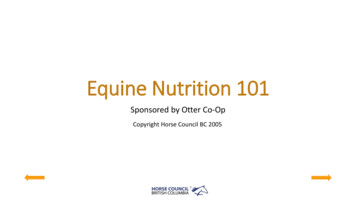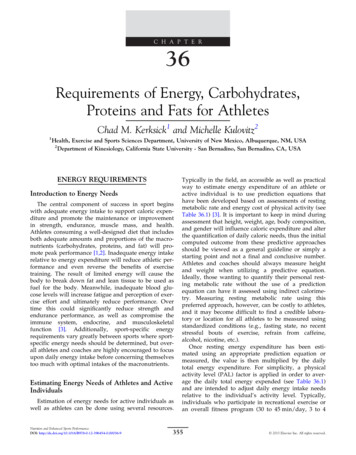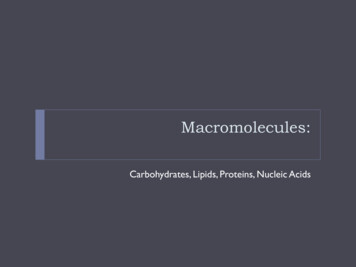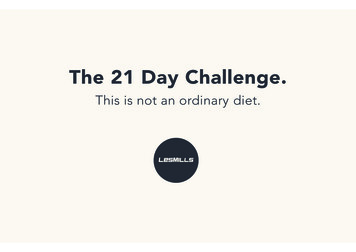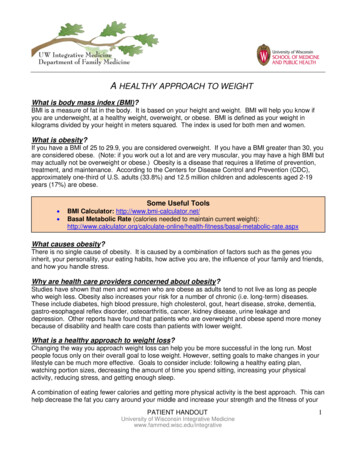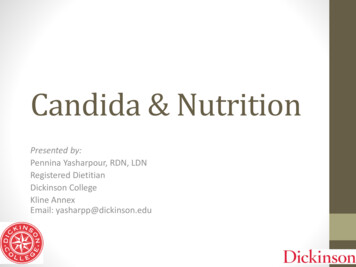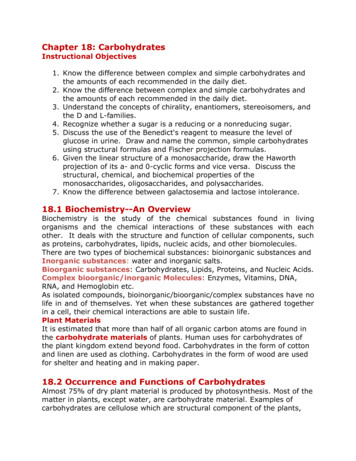
Transcription
Chapter 18: CarbohydratesInstructional Objectives1. Know the difference between complex and simple carbohydrates andthe amounts of each recommended in the daily diet.2. Know the difference between complex and simple carbohydrates andthe amounts of each recommended in the daily diet.3. Understand the concepts of chirality, enantiomers, stereoisomers, andthe D and L-families.4. Recognize whether a sugar is a reducing or a nonreducing sugar.5. Discuss the use of the Benedict's reagent to measure the level ofglucose in urine. Draw and name the common, simple carbohydratesusing structural formulas and Fischer projection formulas.6. Given the linear structure of a monosaccharide, draw the Haworthprojection of its a- and 0-cyclic forms and vice versa. Discuss thestructural, chemical, and biochemical properties of themonosaccharides, oligosaccharides, and polysaccharides.7. Know the difference between galactosemia and lactose intolerance.18.1 Biochemistry--An OverviewBiochemistry is the study of the chemical substances found in livingorganisms and the chemical interactions of these substances with eachother. It deals with the structure and function of cellular components, suchas proteins, carbohydrates, lipids, nucleic acids, and other biomolecules.There are two types of biochemical substances: bioinorganic substances andInorganic substances: water and inorganic salts.Bioorganic substances: Carbohydrates, Lipids, Proteins, and Nucleic Acids.Complex bioorganic/inorganic Molecules: Enzymes, Vitamins, DNA,RNA, and Hemoglobin etc.As isolated compounds, bioinorganic/bioorganic/complex substances have nolife in and of themselves. Yet when these substances are gathered togetherin a cell, their chemical interactions are able to sustain life.Plant MaterialsIt is estimated that more than half of all organic carbon atoms are found inthe carbohydrate materials of plants. Human uses for carbohydrates ofthe plant kingdom extend beyond food. Carbohydrates in the form of cottonand linen are used as clothing. Carbohydrates in the form of wood are usedfor shelter and heating and in making paper.18.2 Occurrence and Functions of CarbohydratesAlmost 75% of dry plant material is produced by photosynthesis. Most of thematter in plants, except water, are carbohydrate material. Examples ofcarbohydrates are cellulose which are structural component of the plants,
starch the energy reservoir in plants and glycogen (animal starch) found inanimal tissues and human body in smaller quantities. Plant products are themajor source of carbohydrates and average human diet contains 2/3 ofcarbohydrates. Recommended percents in the daily diet:Recommended carbohydrates 60 %Recommended sucrose less than 10%Usefulness of carbohydrates is their ability to produce energy whenthey under go oxydation during respiration. Storage carbohydrate, in theform of glycogen, provides a short-term energy reserve for bodily functions.Carbohydrates supply carbon atoms for the synthesis of other biochemicalsubstances (proteins, lipids, and nucleic acids). Carbohydrates also form apart of the structural framework of DNA and RNA molecules.Carbohydrates linked to lipids as discussed in Chapter 19 are structuralcomponents of cell membranes. Carbohydrates linked to proteins asdiscussed in Chapter 20 function in a variety of cell–cell and cell–moleculerecognition processes as useful markers forantibodies.18.3 Classification of CarbohydratesOrganic compounds containing many -OH groups (polyhydroxy), andaldehydes or ketones functional groups. By convention, the ending "-ose" isreserved for sugars (e.g. sucrose and glucose) in the class ofcarbohydrates.Carbohydrates are produced by the process of photosynthesis in which sixcarbon sugars or hexoses are produced using energy of sunlight, greenpigment chlorophyll, CO2 and H2O by green plants. The hexoses producedare the raw material for the biosynthesis of glycogen, fats, proteins andnucleic acid in living systems.Simpler Formula for Cabohydrates: CnH2nOn or Cn(H2O)n (hydrates of C) n number of atomsMonosaccharidesThey consist of one sugar containing 3,4,5,6 and 7 carbon atoms and areusually colorless, water-soluble, crystalline solids. Some monosaccharideshave a sweet taste. Examples of monosaccharides include glucose(dextrose), fructose (levulose), galactose, xylose and ribose.Disaccharidesa sugar (a carbohydrate) composed of two monosaccharides.OligosaccharideAn oligosaccharide is a saccharide polymer containing a small number(typically 3-10 monosaccharidesPolysacharides
Are relatively complex carbohydrates. They are polymers made up of manymonosaccharides joined together by glycosidic bonds. They are insoluble inwater, and have no sweet taste.Monosaccharide structures and typesAldoses :Aldehyde sugars are called aldoses.Ketoses: Ketone sugars are called ketoses.Drawing Sugar Molecules Linear structure-Fischer projection of a monosaccharideAldoseKetose Haworth projection showing cyclic forms: - and - forms.The normal form of most sugars is in a cyclic hemiacetal form shown as aHaworth projection. In solution, less than 1% of a sugar will be in the linearform as shown in Fischer structure below on the right. In solution, over99% of the sugar will be in a cyclic ring structure which is represented byHaworth structures on the left. The preferred form varies from sugar tosugar: some prefer to be a 6-member ring "pyranose", like glucose.The cyclic ring structures of sugars are formed by the intramolecularhemiacetal formation as we described in Chapter 15.ALDEHYDE sugar or aldoses alcohol --- hemiacetal (cyclic ring)KETONE sugar or ketoses alcohol --- hemiketal (cyclic ring)
They are polyhydroxy aldehydes (sucah as glucose)or ketones (such asfructose) or compounds that produce such substances upon hydrolysis.Sugars are classified according to their structures: according tonumber of carbon atoms in the sugar and number of sugar units/molecule ina polymer formed by the glycosidic bonds.Number fo carbon atoms Triose sugar units containing three carbon atomsTetroses sugar units containing four carbon tomsaPentoses sugar units containing five carbon atomsHexoses sugar units containing six carbon atomsSteps for drawing Fischer structures of sugars:A monosaccharides can be "sorted" according to the length of the carbonchain in the sugar unit.1. write the carbon chain vertically with the aldehyde or ketone grouptoward the top of the chain.2. number the carbons.3. place the aldehyde or ketone group.4. place H and OH groups.5. identify the chiral centers.6. note the highest numbered chiral center to distinguish D and L sugars.7. write the correct common name for the sugar.Aldose-Trioses
HexosesMnemonics for remembering sugar namesAll(allose) altruist (altrose) gladly (glucose) make (mannose) gum(gulose) in (idose) gallon (galactose) tanks (tallose)Number fo units Saccharide- (derived from Latin for sugar) is the chemical name for asugar unit: Monosaccharide (one sugar unit); Disaccharide (two sugar units); Oligosaccharide (2 to 10 sugar units); Polysaccharide (over 10 sugar units).Monosaccharides also can be named based on their functional groups.Aldoses: Monosaccarides with aldehyde functional group. E.g. DglucoseKetoses: Monosaccarides with keto functional group. E.g. D-fructoseSimple carbohydrates: Monosaccharide and Disaccharide of simplesugars such as glucose or fructose. Disaccharide are two monsaccharidesconnected by a bridging O atom called a glycosidic bond as in sucrose.Glycosidic bond- covalent bond between a hemiacetal or hemiketal and analcohol.Glycoside- compound formed when a sugar in the cyclic form is bonded toan alcohol through a glycosidic bond to another sugar molecule as shownbelow.
18.4 Chirality: Handedness in MoleculesMost monosaccharides exist in two forms: a “lefthanded” and “right handed” form - same as twohandsTwo types of objects:- Superimposible on their mirror images: -images that coincide at all points when the imagesare laid upon each other -- a dinner plate with nodesign features -- Achiral- Non-superimposible on their mirror images: Chiral HOHCH2OHProperties of light Ordinary Light: Move in all directions Plane polarized light move only in one direction (see Figure on right below) Plane polarized light is rotated clockwise(to right) or counterclockwise (to left) when passedthrough enantiomersDirection and extent of rotation will depend upon theenantiomerSame concentration of two enantiomers rotate light tosame extent but in opposite directionThe way to tell apart the handedness of a molecule is to expose them toplane polarized light
Light is passed through a polarized filter. A solution of an optical isomer willrotate the light one direction.Classification of the molecule based on the rotation of planepolarized light.Dextrorotatory- rotate clockwise shown using ( ) symbol or- usually D isomersLevorotatory- rotate anti-clockwise shown using (-) symbol or- usually L isomers18.5 Stereoisomerism: Enantiomers and DiastereomersStereoisomers are isomers that have the same molecular and structuralformulas but differ in the orientation of atoms in space.Two types:Enantiomers are stereoisomers whose molecules are nonsuperimposablemirror images of each other. Molecules with chiral center.Diastereomers are stereoisomers whose molecules are not mirror imagesof each other. They have more than one chiral centers.Diastereomers (or diastereoisomers) are stereoisomers that are notenantiomers (non-superposable mirror images of each other). Diastereomerscan have different physical properties and different reactivity. In anotherdefinition diastereomers are pairs of isomers that have opposite
configurations at one or more of the chiral centers but are not mirror imagesof each other.ExampleTartaric acid contains two asymmetric centers, but two of the "isomers" areequivalent and together are called a meso compound. This configuration isnot optically active, while the remaining two isomers are D- and L- mirrorimages, i.e., enantiomers. The meso form is a diastereomer of the otherforms.18.6 Designating Handedness Using Fischer ProjectionsFischer projection formulas - a method for giving molecular chiralityspecifications in two dimensions. A Fischer projection formula is a twodimensional structural notation for showing the spatial arrangement ofgroups about chiral centers in molecules.The four groups attached to the atom at the chiral center assume a tetrahedralgeometry and it is governed by the following conventionsVertical lines from the chiral center represent bonds to groups directed into theprinted page. Horizontal lines from the chiral center represent bonds to groupsdirected out of the printed page.
In a Fischer projection formula a chiral center (Carbon) is represented as theintersection of vertical and horizontal lines Functional groups of high prioritywill be written at top D and L system used to designate the handedness ofglyceraldehyde enantiomers.18.7 Properties of EnantiomersAs the right and left handed baseball players can’t use same glove (chiral)but can use same hat (achiral) molecules behaves similarly. Two members of enantiomer pair (chiral) react differently with otherchiral molecules thus only one will fit into a enzyme.Enantiomeric pairs have same solubility in achiral solvents like ethanol andhave different solubility in chiral solvent like D-2-butanol. Enantiomers have same boiling points, melting points and densities all these are dependent upon intermolecular forces and chiralitydoesn’t depend on themEnantiomers are optically active: Compoundsthat rotate plane polarized light.Our body responds differently to different enantiomers:One may give higher rate or one may be inactiveExample: Body response to D form of hormone epinephrine is 20 timesgreater than its L isomer.
18.8 Classification of MonosaccharidesTriose --- 3 carbon atomsTetrose -- 4 carbon atomsPentoses – 5 carbon atomsHexoses -- 6 carbon atomsAldoses: Monosaccharides with one aldehydegroupKetoses: Monosaccharides with one ketone groupCombined # of C atoms and functional group:Example: Aldohexose: Monosaccharide with aldehydeCHOgroup and 6 C atomsAldohexose: Monosaccharide with aldehydeHOHgroup and 6 C atoms – D-glucoseKetohexose: Monosaccharide with aldehyde group and 6 C atoms – (aldohexose)D-Fructose(ketohexose
18.9 Biochemically Important MonosaccharidesGlucoseGlucose is the most common monosaccharide consumed and is thecirculating sugar of the bloodstream. Insulin and glucagon regulateblood levels of glucose1. Most abundant in nature2. Nutritionally most important3. Grape fruit good source of glucose (20 - 30% by mass) -- alsonamed grape sugar, dextrose and blood sugar (70 - 100mg/100 mL of blood)4. Six membered cyclic formCHOHHOFructoseFructose is slightly sweeter than glucose. It is an intermediary inmetabolism and is found in many fruits.1. Ketohexose2. Sweetest tasting of all sugars3. Found in many fruits and in honey4. Good dietary sugar-- due to higher sweetness5. Five membered cyclic formGalactoseGalactose, a component of lactose (milk sugar) is also found insome plant gums and pectins. Galactosemia results from inabilityto metabolize galactose. If treated, galactosemia can bemanaged medically. Untreated galactosemia may result in mentalretardation, liver damage, or death.Milk sugarSynthesize in humanAlso called brain sugar-- part of brain and nerve tissueUsed to differentiate between blood typesSix membered cyclic formHOHHOHD-Glucose(aldohexose)CHOHRibose and deoxyribose are aldopentose components of DNA andRNA1. Part of RNAHOHHOHHOHOHCH2 .OHHOHHOHHOHCH2 OHD-Ribose(aldopentose)(
2. Part of ATP3. Part of DNA4. Five membered cyclic form18.10 Cyclic Forms of Monosaccharides2 forms of D-glucose: Alpha-form: -OH of C1 and CH2OH of C5 are on opposite sides Beta-form: -OH of C1 and CH2OH of C5 are on same sides18.11 Haworth Projection FormulasAs useful as the Fischer projection is (it is an excellent way to keep track ofrelative stereochemistry), it gives a poor sense of the real structure ofcarbohydrates. (See Hemiacetal Formation in chapter 15.) The Haworthprojection is a way around this limitation that does not require you to try toconvey the complete 3D image of the molecule.Sugars in Haworth projection can be classified according to the "ring size"(five- furanoses or six-pyranoses ) which they assume in solution. A66CH2 OHCH 2OH54OHO1OH23OH -D-GlucoseOH54OHOOH23OH -D-GlucoseOH1
sugar with fewer than five carbons can not form a stable ring.FuranosesWe divide Haworth projections into two classes: furanoses and pyranoses.The furanoses or 5-member ring hemiacetals are drawn with the oxygen atthe top of a pentagon. The horizontal bond at the bottom is assumed to becoming out of the plane toward you. Thus, the five-member ring is in aplane perpendicular to the page. Vertical lines are drawn on each carbon toindicate attachements above and below the plane of the 5-member ring. Insolution, fructose, ribose, and deoxyribose will exist as five memberfuranose rings. The furanose ring resembles the cyclic ether called furan. Afuranose form of the sugar ribose is a good example:Pyranoses6-member rings ("pyranoses") have a slightly different but quite horizontal bond runs along the bottom. The oxygen in the ring is placed meric position) is placed at the extreme right. In solution, glucose,galactose, and mannose will exist as six member pyranose rings. The sugarring resembles the cyclic ether called pyran. Again, the bond at the bottomis assumed to be coming out of the plane and vertical bonds are used toindicate substituents above and below the 6-member ring.Rules for converting a Fischer structure to a Haworth structure.1. draw either a pyranose or a furanose ring depending on the sugar.2. attach "flagpole" carbon above the ring and number the carbons.3. attach -OH and -H groups using the conventions below:FischerHaworth-OH to right-OH down (below ring)-OH to left-OH up (above ring)
4a. For -anomer, place the anomeric carbon -OH "opposite" the flagpolecarbon.4b. For -anomer, place anomeric carbon -OH "same side" as the flagpolecarbon.Anomeric carbon- the new chiral center created when the sugar ring is formed.Anomers- the two new sugar stereoisomers created by ring closure.
Practice ExerciseWhich of the monosaccharides glucose, fructose, galactose, and ribose haseach of the following structural characteristics? (There may be more thanone correct answer for a given characteristic)a. It is a pentose.b. It is a ketose.c. Its cyclic form has a 6-membered ring.d. Its cyclic form has two carbon atoms outside the ring.Answers:a. Ribose b. Fructose c. Glucose, galactose d. Fructose18.12 Reactions of MonosaccharidesFive important reactions of monosaccharides: Oxidation to acidic sugars Reduction to sugar alcohols Glycoside formation Phosphate ester formation Amino sugar formationThese reactions will be considered with respect to glucose. Other aldoses, aswell as ketoses, undergo similar reactions.a) Oxidation to acidic sugarsReducing sugars- a sugar aldehyde or ketone which can be oxided to anacid and drive the reduction of a metal ion. Oxidation can yield threedifferent types of acidic sugars depending on the type of oxidizing agentused:Weak oxidizing agents such as Tollens and Benedict’s solutions oxidize thealdehyde end to give an aldonic acid.
A reducing sugar is a carbohydrate that gives a positive test with Tollens andBenedict’s solutions.Aldehyde sugars should show positive test for the Benedict's test because ofthe aldehyde functional group in the molecule.Benedict's Test for aldehydes:Oxidation can yield three different types of acidic sugars depending on thetype of oxidizing agent used:Weak oxidizing agents such as Tollens and Benedict’s solutions oxidize thealdehyde end to give an aldonic acid.A reducing sugar is a carbohydrate that gives a positive test with Tollens andBenedict’s solutions.However, keto sugars also gives a positive test for Benedict's test becauseketo sugars could be converted to aldehyde sugars through the enediolintermediate under the reaction conditions. Therefore, all monosaccaridesboth aldoses and ketoses show a positive behavior in the Benedict's test.and considered as reducing sugars. In biological systems keto form ofaldehyde sugars (aldoses) are converted to ketone sugars (ketoses) viaenediol (enol) froms as shown below. Therefore D-fructose which is a ketoneor keto sugar (ketose) will give a positive test for Benedict's test because ofthe ability of ketoses to get converted to aldoses (aldehydes).Use of the Benedict's reagent to measure the level of glucose inurine.This test have been used in old days to detect excess boold sugar in diabeticpatients. This test shows positive behavior for all reducing sugars whichincludes maltose and lactose and therefore not an very good test for glucosein the urine.
Enzyme oxidationIn biochemical systems enzymes can oxidize the primary alcohol end of analdose such as glucose, without oxidation of the aldehyde group, to producean alduronic acid.b) Reduction to sugar alcohols: The carbonyl group in a monosaccharide(either an aldose or a ketose) is reduced to a hydroxyl group using hydrogenas the reducing agent.The product is the corresponding polyhydroxy alcohol - sugar alcohol.Sorbitol - used as moisturizing agents in foods and cosmetics and as asweetening agent in chewing gum
c) Glycoside formationSimple carbohydrates: Monosaccharide and Disaccharide of simplesugars such as glucose or fructose. Disaccharide are two monsaccharidesconnected by a bridging O atom called a glycosidic bond as in sucrose.Glycosidic bond- covalent bond between a hemiacetal or hemiketal and analcohol.Glycoside- compound formed when a sugar in the cyclic form is bonded toan alcohol through a glycosidic bond to another sugar molecule as shownbelow.Phosphate ester formation18.13 DisaccharidesA disaccharide forms by reaction of the -OH group on the anomeric carbon ofone monosaccharide with an –OH group of a second monosaccharide.The linkage between monosaccharides in a disaccharide is referred to as aglycosidic linkage and is named according to the number of the carbon atwhich the linkage begins and the carbon on the second monosaccharide atwhich the linkage ends.-The glycosidic linkage is also designated a or β, depending upon whetherthe conformation at the anomeric carbon is up or down.
Sucroseglucose fructose --- glu , (1---2) fructose sucrose, a non reducingsugarConsider the three disaccharide structures maltose, lactose and sucrose andexplain why sucrose is NOT a reducing sugar.Disaccharides with (1---4), (1---4) and (1 ---2 ) glycosidic bonds thatyield disaccharide, maltose, lactose and sucrose, respectively. Both (1--4) and (1---4) glycosidic bonds leave one hemiacetal or hemiketal free andthese ends will show a postive behavior for the Benedict's test. E.g maltoseand lactose. Fructose having (1 ---2 ) glycosidic bondhave protected
acetal and ketal groups which are unable to undergo enediol conversion orreaction with Benedict's reagent. Therefore fructose is considered as a nonreducing sugar.Maltoseglucose glucose --- glu (1---4) glumaltose, a reducing sugarLactosegalactose glucose --- gal (1---4) glulactose, a reducing sugar18.14 General Characteristics of Polysaccharides Storage polysaccharidesEnergy storage - starch and glycogenStructural polysaccharidesUsed to provide protective walls or lubricative coating to cells cellulose and mucopolysaccharides.Structural peptidoglycansBacterial cell walls
18.15 Storage PolysaccharidesAmyloseAmylopectinamylose (1---4) glucoselinear moleculecoils upless water solublenon reducing sugarPlant Starchamylopectin (1---4) and (1---6) glucosebranched moleculeopen spiral moleculemore water solublenon reducing sugar
GlycogenAnimal Starchglycogen (1---4) and (1---6) glucosebranched moleculeopen spiral moleculemore water solublenon reducing sugarCellulose
Cellulose (1---4) glucoseribbon moleculeribbons stackwater insolublenon reducing sugarStructural Polysaccharides:Chitin (1---4) N-acetylglucosamineribbons stackwater insolublenon reducing sugar chitinSee bacterial cell wall, text book page 160, forstructure of N-acetylglucosamine18.16 Structural PolysaccharidesMucopolysaccharidesAMINOSUGAR or N-acetyl-D-glucosamine: glucose-derivative with anacetylated amino group on C-2 as found in N-acetylglucosamine.Deoxysugar or D-deoxyribose: ribose-derivative with an oxygenmissing on C-2.18.17 Acidic Polysaccharides
18.18 Glycolipids and Glycoproteins18.19 Dietary Considerations and CarbohydratesThe difference between galactosemia and lactose intolerance.GalactosemiaMilk products which contain lactose are conversted to galctose and glucosein the digestive track. Both glucose and galactose are absorbed by the bodyand used to produce energy.However, galactose has to be convertedphosphorylated glucose before it can be used by the body. Galactosemia is agenetic desease caused by a lack of enzymes necessary for the conversionof galactose to phosphorylated glucose which is used in the cellularmetabolism or glycolysis. A toxic compound formed from galactoseaccumulates in people with galactosemia. Treatment for galactosemia is theuse of non dairy products which does not contain lactose.LactoseintoleranceMilk products which contain lactose are conversted to galctose and glucosein the digestive track using an enzyme called lactase. People with lactoseintolerance does not produce very little or no lactase and the undiagestedlactose in the intestinal tract are metabolised by bacteria releasing CO 2 andother organic acids causing cramping and diarreha. People with thiscondition can take supplements with lactase along with their food and enjoyeating dairy products or use a diet deviod of lactose comming from milkproducts.Lactose intolerance is present in 75 percent of adults the world over. Itsclinical manifestations include abdominal pain, bloating, gas and diarrheaupon consumption of dairy products. An intestinal enzyme called lactasesplits lactose into two glucose molecules, enabling them to pass through theintestinal walls and into the bloodstream. Lactase deficiency leads to aninability to digest lactose, which becomes fermented by bacteria, producinghydrogen and other gases. Lactose also attracts water molecules into thecolonic lumen, causing loose stools or diarrhea. What is the differencebetween lactose intolerance and milk allergy? Intolerance to lactose ishardly immunological in origin and occurs during late childhood oradolescence. Milk allergy, on the other hand, is an allergic reactionmanifested by diarrhea, vomiting, abdominal pain, asthma, hives andsometimes, anaphylaxis. Allergy occurs during the first four months of lifeand ceases by the baby's first birthday. The simplest way to treat lactoseintolerance is by avoidance of dairy products. Tests used to diagnose theproblem are lactose intolerance test, hydrogen breath test and stool aciditytest. To minimize symptoms of lactose intolerance, space the consumption ofmilk throughout the day. Lactose- containing foods should be eaten
together with other foods. Enzyme supplements are also helpful inconverting lactose consumed to glucose and galactose.
A monosaccharides can be "sorted" according to the length of the carbon chain in the sugar unit. 1. write the carbon chain vertically with the aldehyde or ketone group toward the top of the chain. 2. number the carbons. 3. place the aldehyde or ketone group.

